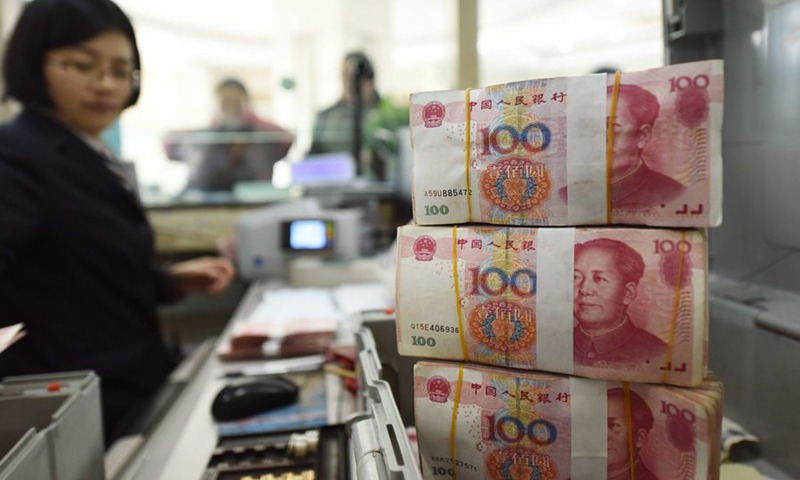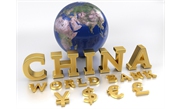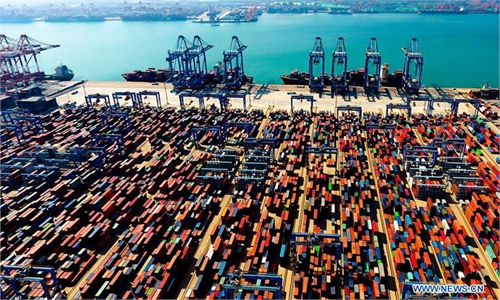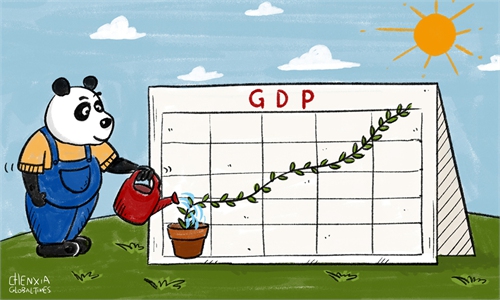
A bank staff member checks RMB banknotes at a bank in Lianyungang, east China's Jiangsu Province, Jan. 7, 2016.Photo:Xinhua
China's post-COVID-19 comeback continues to gain steam as its economy posted growth in all sectors in the second quarter and GDP expanded 12.7 percent in the first half of the year, according to data released by the National Bureau of Statistics on Thursday.
This growth is seen by Chinese economists as a "miracle" considering the speed, scope and sustainability of China's transition from the epidemic-hit situation in early 2020 to the current economic state, although they also pointed out the uncertainties China is facing, such as rising commodity prices and external pandemic risks, as signs of growth slowdown have emerged.
According to data released by China's National Bureau of Statistics on Thursday, China's GDP grew by 12.7 percent year-on-year in the first half of the year to 53.2 trillion yuan ($8.2 trillion). On a two-year average basis, China's GDP grew 5.3 percent.
The economy surged by 7.9 percent in the second quarter, slowing from 18.3 percent in the first three months. In terms of a two-year average, however, the second quarter growth reached 5.5 percent, outpacing the first quarter's 5 percent growth.
Former NBS chief economist Yao Jingyuan said at a press briefing of the State Council Information Office on Thursday that the steady growth in the January-June period indicates that China will be able to complete all economic goals set at the beginning of the year.
This should be among, or even likely to be, the highest half-year growth that any country could achieve, experts predicted, considering that many countries recorded slower or negative growth for the second quarter. In comparison, the US economy surged by 6.4 percent in the first quarter; it has not disclosed second quarter figures yet.
"The growth shows that China's economy has primarily walked out of the impact of coronavirus and has already returned to pre-COVID-19 levels," Dong Dengxin, director of the Finance and Securities Institute of Wuhan University, told the Global Times.
China's economy will also provide momentum to the world's post-coronavirus growth. Experts have expected that China could contribute about 1.4 percentage points to the world's GDP growth this year, being the second largest economic driver following the US to the world's economic recovery.
China has set a growth target for 2021 at over 6 percent. The country's GDP grew by 2.3 percent in 2020.
Balanced and healthy
Economists have appraised China's H1 GDP growth as being increasingly balanced, refuting some foreign media's assertion, as the major drivers behind economic growth all reported a double-digit yearly growth and a steady two-year average growth of between 4-7 percent.
Consumption and investment, which used to lag behind manufacturing in terms of recovery, are also edging up faster, showing that China's economic imbalance is "narrowing," Wu Chaoming, chief economist at Chasing Securities, told the Global Times.
Total retail sales of consumer goods increased by 23 percent in the first half of 2021, at 21.2 trillion yuan. This brought the two-year average growth of China's H1 retail sales to 4.4 percent, up 0.2 percent compared with the first quarter.
Fixed-asset investment grew by 12.6 percent from January to June, sending the two-year average growth to 4.4 percent. By comparison, industrial output rose by 15.9 percent on a yearly basis over the first six months this year.
Analysts also stressed that China's economic rebound is one of "high-quality" and "healthy," as some low-end, inefficient capacities have been eliminated by this coronavirus crisis and industrial structures being improved further.
"Although the government has put a lot of focus on stimulating the economy, it is also making sure that the economy's development has a balanced structure instead of just 'flood like' strong stimulus policies," said Hu Qimu, chief research fellow at the Sinosteel Economic Research Institute, citing the example of China raising its carbon emissions target amid the economic reboot and on the way to build the world's largest carbon trade market, scheduled to starting trading in July.
The NBS data also showed that China's high-tech manufacturing added values rose by 22.6 percent in the first half of the year, with production of clean-energy vehicles and industrial robots surging by 205 percent and 69.8 percent, respectively.
Rising uncertainties
However, experts also cautioned that economic uncertainties are accumulating for the second half of the year, arising from multiple factors including changes in overseas demand and rising commodity prices. Those factors, along with a lesser base effect, should slow China's economic growth in the third and fourth quarters, they said.
The slowing trend has already shown some signs in the NBS data. For example, China's industrial output increased 8.3 percent in June from a year earlier, down from 8.8 percent growth in May.
Xu Xianchun, a former deputy head of the NBS, told the Global Times on Thursday that China's third-quarter GDP growth will keep growing at a "relatively high" rate partly due to a low-base effect and as more development potentials unfold. But such rate will "certainly" go down from that of the second quarter.
"For the whole year, the GDP will taper down gradually as the base effect eases. The second half GDP will drive up the economy about 3 percentage points, underpinning the full-year growth at between 8.5 to 9 percent, a relatively high speed," Xu said.
Xu said China's economy will face many uncertainties in the upcoming months. For example, China's exports could wither in the second half, as the resumption of overseas manufacturing - amid global effective control of pandemic - will divert orders originally set to flow to China.
Yao said that the biggest difficulty in the first half year was the price hikes of raw materials, which created a burden for manufacturers.
"The situation could be eased in the second half as China has vowed to stabilize prices and more measures to aid factories are expected," Yao said.
Experts also said that China needs to push forward sweeping reforms to increase residents' income to further spur consumption, as the consumption sector has not yet recovered to pre-COVID-19 levels.
"China has a huge domestic market, with about 400 million in the middle-income category — equivalent to the combined population of the US and Japan. Building on a vigorous consumer market in the first six months, it is important to further release such consumption potential in the second half," Yao noted.






